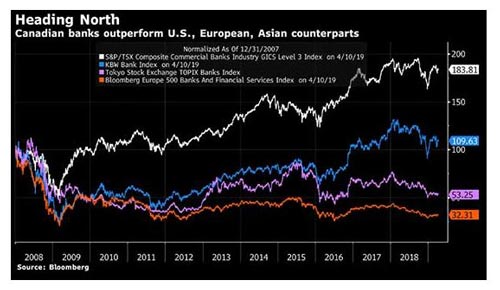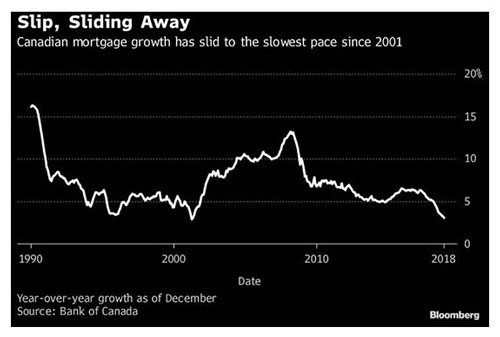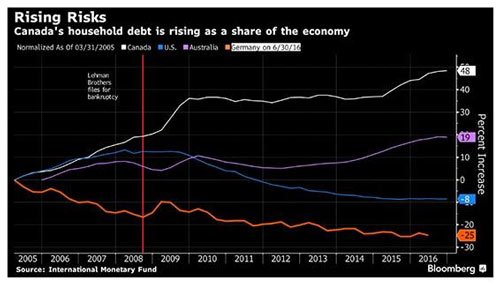I'd bet Canada's not the first country that comes to mind when you think of the words "financial crisis."
Indeed, normally, the United States' northern neighbor is a bastion of fiscal and economic sobriety, especially when compared to other big, developed economies like China, the United States, and the European Union.
Take the global "Great Recession" for instance: It did impact Canada, but not until global oil and resource prices began to tank. That brutal downturn was an altogether shorter and shallower affair in Canada. The Bank of Canada (begrudgingly) slashed interest rates to the bone, but it never went on the freewheeling bond-buying binge of quantitative easing as central bankers did in the United States, Europe, and Japan.
Canada's "Big Six" banks - the National Bank of Canada, the Royal Bank of Canada, the Bank of Montreal, the Canadian Imperial Bank of Commerce, the Bank of Nova Scotia, and Toronto-Dominion Bank - were prohibited by the country's regulators from indulging in the reckless casino banking that merrily went on, unimpeded by common sense, south of the border.
Their big banks, while every bit as "systemically important" and "too big to fail" as their American counterparts, were never in any danger of insolvency. Contrast that with Lehman Brothers (or Deutsche Bank, which is still - dollar for illusory, notional dollar - the most dangerously leveraged bank on the face of the Earth).
But whether they're in Manhattan, Frankfurt, Ulaanbaatar, the Sea of Tranquility, or even Toronto... bankers will be bankers. Whenever there's a buck, shekel, ruble, peso, or rupee to be had, you can bet someone will make a risky, stupid play for it.
There's no rainy day they won't totally ignore until it's too late.
And that's what's happening at some Canadian banks right now.
It'll end in disaster for them - history shows it always does - but there's a big, fat, slow pitch unfolding right now that's too rich to pass up.
[mmpazkzone name="in-story" network="9794" site="307044" id="137008" type="4"]
Very Troubling Reports from the Great White North
In addition to the qualities I just mentioned, Canada has an altogether more sane history of government and private debt management than its peers in the United States and Europe.
For decades, Canadian banks have been able to maintain superior credit quality standards on their loans. It's unfathomable by American "your job's your credit" standards, I know, but if you're a bad credit risk, you're - historically speaking - unlikely to be able to get a loan from a Canadian bank.
Watch Now: Serial entrepreneur Neil Patel reveals how to achieve the American Dream... for as little as $50. Click here...
At least that used to be the case...

Sadly, however, this credit sobriety is starting to give way to fiscal madness, as the numbers below make it all too clear.

Canadian Banks Staring at Scary Levels of Impaired Loans
The Q2 reports from banks like the Canadian Imperial Bank of Commerce (CIBC), the Royal Bank of Canada (RBC), and The Bank of Montreal (BOM) have recently come out, and the math is a bit troubling.
The math says there is now an undeniable deterioration in Canadian commercial loans, and that deterioration is gaining momentum.
At the CIBC, for example, the level of impaired commercial loans on its books has risen by an astounding 77% year over year for the latest quarter. Folks, read that again: A SEVENTY-SEVEN PERCENT INCREASE in impaired commercial loans.
Member Notice: You have a chance to become one of the first people in the world to experience the massive profit potential delivered by a V3 Effect. Click here to see it in action now.
For now, the deterioration in consumer loans has increased by only 2.8%, but the overall number of total impaired loans on this bank's books has risen by a remarkable 34% year over year.
Credit jocks like myself understand that credit cycles typically play out gradually; they creep up on investors like a slow bleed rather than a sudden shock.

Even the great subprime crisis in the States took years to metastasize into a full-on "uh-oh" moment.
And let me be clear: The numbers I'm sharing here don't suggest some Canadian financial Armageddon brewing. In fact, Canada's banks are nowhere near the dangerous levels of the U.S. banks heading into 2008.
But why this is happening is important. It's compelling, and as you'll see in a minute, not just as a valuable market history lesson or cautionary tale, either.
There's some serious money to be made on the opportunity developing in Canada's banking sector, but we need to understand where this opportunity is coming from...
Here's Why Canada's Bankers Are "Behaving Badly"
Canada, as a national economy, relies heavily upon commodities in general and crude oil in particular.
Over the years, however, U.S. oil production has successfully managed to become cheaper in the States, which has had a gradual but nevertheless unambiguously negative impact on Canada.
YOU KNOW IT IN YOUR GUT: Look at how things are going. Financial turmoil is coming just around the corner, maybe just a few months away. Click here...
Bank managers in Canada are now seeing the sting of this trend on their once-safe balance sheets as the levels of impaired commercial loans rise dramatically.
As anyone over the age of 10 can tell you at this point, deteriorating credit can send banks into a tailspin as the loans they hold make the slow - then rapid - fall from the sublime to the ridiculous.
Of course, we saw this in epic form during the subprime disaster of 2008.
Bad loans, alas, have a direct and undeniable impact on bank earnings in general and on bank health in particular.
As loans begin to show weakness, one would expect bank management (and of course bank regulators, who are really just other bankers) to significantly increase reserve levels to intelligently brace for the inevitable shock of increasing loan defaults.
Rising levels of impaired loans, after all, are a clear and obvious warning signal to prepare for a rainy day and thus increase a bank's level of safety reserves.
This is known as counter-cyclical earnings management, and among bankers, it's about as popular as botulism poisoning.
See, increasing a bank's reserves for an impending rainy day requires a reallocation of capital, and that reallocation - no matter how prudent, how necessary, or how responsible - will lead to a direct hit on earnings and, by extension, stock prices.
And bank managers, like CEOs across an increasingly drunken spectrum of stock-driven decision making in the C-suites, hate to see earnings decline for even a nanosecond.
This short-term obsession with earnings has made bank executives less attentive to the longer-term importance of preparing for a rainy day in the credit cycle.
Such lack of prudence, however, just makes the storm ahead infinitely worse for their share prices.
That is, reserve levels should rise in pace - in fact, even faster - than the rising pace of impaired loans. And with a 77% annual increase in such impaired loans, one would hope the banks' reserve levels are rising as well.
To model this out, as we do at the hedge fund level, one simply needs to create a ratio of the reserve allowance (i.e., the rainy-day fund for loan losses) and divide it by level of impaired loans on the books.
The bigger the ratio, the safer the bank. But also: The bigger the ratio, the greater the short-term hit to bank earnings and stock prices.
So naturally, we see no meaningful reserve increases at any of the major Canadian banks.
Ironically, at some point very soon, these myopic banks won't be able to manage earnings because they were trying to prop them up too long at the expense of sound risk management.
In other words, by ignoring risk today, they are only putting their earnings at greater risk for tomorrow. The ironies do abound.
But what's bad for bad bankers can be very good for informed, savvy investors.
This is a classic "fat pitch," to use the American term - and one that savvy folks out there will want to swing at. Here's how...
There's Another Lucrative "Big Short" Brewing
Right now, we are seeing clear and mathematical (not theoretical) deterioration in the quality of commercial loans across the books of the Canadian banks. Residential loans, however, have yet to show similar impairment. But the operative word here is "yet."
Again, credit cycles move slowly, then all at once. At some point, there can be a convergence of impaired commercial and residential loans on the books of these banks, which means earnings will tank - and with them, the share prices of Canadian financials.
In other words, get ready to short the Canadian banks, like Steve Eisman, money manager for Neuberger Berman Group. This "Big Short" money manager foresaw the collapse of the U.S. housing market, and back in he April was predicting a "20%-plus" decline for Canadian bank stocks as credit conditions "normalize" and loan losses jump.
"Canada has not had a credit cycle in a few decades, and I don't think there's a Canadian bank CEO that knows what a credit cycle really looks like," he said. "I just think psychologically they're extremely ill-prepared."
Of course, bankers themselves like to ramp up the "deny, deny, deny" game just as the news gets bad. For his part, Brian Porter, the Bank of Nova Scotia's CEO, is fervently denying that there's much risk at all in Canadian banks, reminding one and all that those who try to short them typically get squeezed.
To that, I'd say: As with any good trade, the key is to know where the hockey puck is headed, not where it is now. And for now, the Canadian bank stocks are up.
But as impaired loans turn toward defaulting loans, Canadian banks could easily drop by 20% or more in share price value. Short selling is one way to go, if you've got the appetite, but as I've said, I prefer to hedge risk and enjoy many times the gains with put options.
Again, this is a classic setup - and an opportunity to bet against the Canadian banks.
For those of you who are investors rather than traders, such a play may not be for you. Perfectly understandable. That said, it's probably a good idea to insulate your portfolios now from any Canadian bank exposure.
America's No. 1 Pattern Trader Is Kicking Off a LIVE Training Program (with a Shot at $160K)
This is not what you would typically see from Tom Gentile... and it's unlike anything we've ever done before.
This is a simple, powerful way that you can put ALL of Tom's trading power in YOUR hands.
He's hosting his first-ever live training program... and it's the only way you can start making money exactly the way he does it.
Based on his performance this year, you could pocket $160,000 from what you'll learn - in eight weeks flat.
Follow Money Morning on Facebook and Twitter.
About the Author
25-year run as a hedge fund portfolio manager, family office chief investment officer, managing director and general counsel. Internationally recognized expert in credit and equity markets as well as macro risk management.



